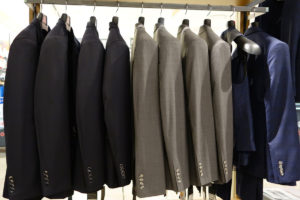 When I was a Loss Prevention Manager we would catch a shoplifter or a dishonest employee and recover merchandise. Depending on the type of case we would sometimes hold the evidence for a few days until the court hearing other times it could be much longer. If a shoplifter refused to plead guilty or requested a jury trial cases could be held up for months if not longer. I had several cases that went on for more than a year. Felony shoplifting cases and juvenile cases in our jurisdiction often meant lengthy wait periods depending on caseloads in the court. I also recall at least one shoplifting case in which the lawyer for the defendant requested extensions three separate times hoping that I would not appear for the hearing and the case would be dropped. No dice, I showed up for each hearing and finally the lawyer entered a guilty plea. The problem with the lengthy cases was that we would have to hold the evidence until the cases were settled. In some situations the police department held the recovered merchandise, such as when they stopped the suspect after the suspect fled the store. When merchandise has to be held for long periods it is possible for it to sit in evidence and be forgotten about. For stores that are too small to have security or Loss Prevention Departments management may be storing that evidence and no one is thinking about following up on cases with their police department or court.
When I was a Loss Prevention Manager we would catch a shoplifter or a dishonest employee and recover merchandise. Depending on the type of case we would sometimes hold the evidence for a few days until the court hearing other times it could be much longer. If a shoplifter refused to plead guilty or requested a jury trial cases could be held up for months if not longer. I had several cases that went on for more than a year. Felony shoplifting cases and juvenile cases in our jurisdiction often meant lengthy wait periods depending on caseloads in the court. I also recall at least one shoplifting case in which the lawyer for the defendant requested extensions three separate times hoping that I would not appear for the hearing and the case would be dropped. No dice, I showed up for each hearing and finally the lawyer entered a guilty plea. The problem with the lengthy cases was that we would have to hold the evidence until the cases were settled. In some situations the police department held the recovered merchandise, such as when they stopped the suspect after the suspect fled the store. When merchandise has to be held for long periods it is possible for it to sit in evidence and be forgotten about. For stores that are too small to have security or Loss Prevention Departments management may be storing that evidence and no one is thinking about following up on cases with their police department or court.
Spring is the perfect time to look through cases and see if there is merchandise that can be returned to inventory. Before you just go in and start looking through evidence closets or lockers that you may have in your store take some things into consideration. Just as police have chains of custody, a store should have a similar program in place. No one should be able to open a security cabinet and start digging through it. A proper evidence locker will have a listing of evidence that is associated with a case number, date and suspect(s) name. This enables the store to track the progress of a case. It also gives reference information so that a call to the Clerk of Court can help their employees find the status of a case. When the locker is opened, there should be a signature sheet with a date and time entry showing when it was accessed. There should also be an evidence release form in the event police have to take custody of property (be aware that they will have their own chain of custody form for you to sign too).
Why is it so important to go through and review for evidence that can be cleaned out? From an inventory standpoint the product could be losing value. I did have merchandise sit in my evidence locker and some SKU’s went clearance as the merchandise had to be held while the case was in limbo. In a few instances merchandise completely dropped from the books and I had to take financial sheets and account for the products. Occasionally police would come by with merchandise from cases I had forgotten about and let me know that they were cleaning out their evidence lockers and a case had been dismissed or adjudicated without any follow up with our store. Again, this was infrequent as most cases were disposed of with me present or a call from the Clerk of Court letting me know the defendant had entered a guilty plea. Our store was large enough that we could absorb some of these lost markdowns or the items dropped from the system without making a major impact on our stock shortage. For smaller stores this could be problematic. Every dollar and piece of merchandise should be accounted for whenever possible at inventory time. The lower the annual sales the more impact each lost or uncounted piece of merchandise has on overall shortage.
What is the solution to potential losses because merchandise is in evidence? Use spring as the time to review what you may have in your evidence locker from shoplifting and employee theft cases. If there are cases that have been sitting for a month or more, place a call to the court that is responsible for the case and ask about the status. If it has been closed on their end you should be able to release the goods back to the store. If it is still awaiting trial or disposition continue holding it in evidence. One final piece of advice, some jurisdictions will permit photos of evidence to suffice for court. Contact your local police department or court to find out their rules and guidelines.
 The big retail stores and thousands of convenience stores across the country try to find solutions to tackle shoplifting and employee theft. The retail industry losses account to $42 billion every year, and it doesn’t seem to be stopping anytime soon.
The big retail stores and thousands of convenience stores across the country try to find solutions to tackle shoplifting and employee theft. The retail industry losses account to $42 billion every year, and it doesn’t seem to be stopping anytime soon. The National Association for Shoplifting Prevention
The National Association for Shoplifting Prevention Some shoplifters are violent. I follow these incidents and they seem to be becoming more frequent. The reasons why are many and there is plenty of blame to go around: State and local governments, courts and lax Judges, parents and even retailers themselves. Much of that is out of our control. We must keep violent and non-violent shoplifters from even entering our stores.
Some shoplifters are violent. I follow these incidents and they seem to be becoming more frequent. The reasons why are many and there is plenty of blame to go around: State and local governments, courts and lax Judges, parents and even retailers themselves. Much of that is out of our control. We must keep violent and non-violent shoplifters from even entering our stores. I recently read over an article opining the phrase “sales cures shrink”. While the author touched on both sides of the coin, I found it interesting that in today’s retail climate, anyone would think that you can simply sell your way out of losses. Let’s cut to the chase here; we’re not bringing in 20% increases over last year, hell we’re lucky to come in flat to last year. Online giants like Amazon are eating up market share like never before and if brick and mortar don’t do something fast, sales will continue to slump.
I recently read over an article opining the phrase “sales cures shrink”. While the author touched on both sides of the coin, I found it interesting that in today’s retail climate, anyone would think that you can simply sell your way out of losses. Let’s cut to the chase here; we’re not bringing in 20% increases over last year, hell we’re lucky to come in flat to last year. Online giants like Amazon are eating up market share like never before and if brick and mortar don’t do something fast, sales will continue to slump.
 I’ve been doing employee theft investigations for years now. Sometimes, they’re a blast. Often, they frustrate me. Not because the person is a thief, but because the loss could be so avoidable if managers would take the time and play offense. Sure, we can run reports and watch video, but all that’s doing is keeping us on the D-Line. You have to play hard and not be afraid to call an audible when needed.
I’ve been doing employee theft investigations for years now. Sometimes, they’re a blast. Often, they frustrate me. Not because the person is a thief, but because the loss could be so avoidable if managers would take the time and play offense. Sure, we can run reports and watch video, but all that’s doing is keeping us on the D-Line. You have to play hard and not be afraid to call an audible when needed.

